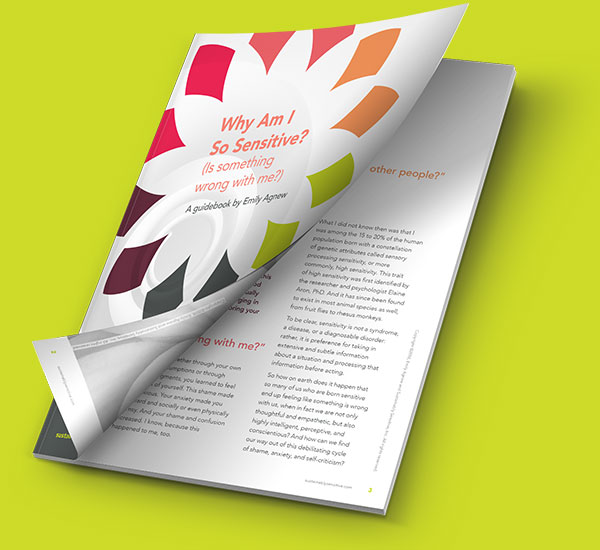I had fun this week interviewing myself about the new book by Jessie Inchauspé, Glucose Revolution, to offer my thoughts about its value to HSPs.
Q: I understand you recently read the 2022 book by Jessie Inchauspé (I’ll call her J.I.), Glucose Revolution: The Life-Changing Power of Balancing Your Blood Sugar. Do you think it’s of value for highly sensitive people?
A: Yes. Two close friends recommended the book. I ended up reading it twice. I do think the information in the book could be really valuable to other HSPs. I may be bringing coals to Newcastle, as my grandmother would have said, because so many of the HSPs I know are very knowledgeable about food and their bodies. But I learned enough from the book to want to let others know about it.
Q: You read it twice?
A: Yes. I tore through it the first time because I was so curious about J.I.’s ten “hacks.” Then I went back and read more slowly so I could really take it all in. The book is deceptively easy to read. J.I. is exceptionally skilled at using metaphors, drawings, and real-life examples to clarify complex concepts. But underneath the light tone, there’s a lot of science. She’s a biochemist. She pulled together a number of studies in writing the book.
The basic premise of the book is that blood sugar spikes are hard on our bodies and minds in multiple ways. Minimizing these spikes, which J.I. calls “flattening your glucose curves”—makes you healthier and happier. She provides 10 “hacks” to help accomplish this (you can read about them here.) But for me, the hacks were only part of the value.
Q: So it’s not a diet?
A: No. It’s about what your blood sugar does after you eat. I wouldn’t have written about the book here if it were a diet, because eating is so individual. What works for me won’t necessarily work for you. But J.I’.s information is “diet agnostic.” You can be vegan, or paleo, or anything in between.
Q: How did a biochemist get into writing a book about eating?
A: J.I. got an unexpected crash course (sorry, bad pun!) in glucose spikes when the startup she worked for asked for volunteers to wear a continuous glucose monitor. She was surprised to discover the extent to which different foods she ate caused her blood sugar levels to spike, then crash.
She started graphing what she was seeing, and soon began to connect the dots around how the spikes affected her mood, her health, her weight, and her energy. She ended up creating an app because so many friends were asking her about this. I really appreciate this aspect of the book: it’s written by an ordinary person who found out the information because of the issues she herself was struggling with.
Q: What are the effects of too many glucose spikes?
A: I highly recommend reading her detailed description of the effects. But in a nutshell, because glucose is the most basic fuel on which our bodies operate, any dysregulation in our metabolism affects our health in a wide range of ways. On the short term, glucose spikes contribute to cravings, chronic fatigue, poor sleep, impaired immune function, and migraines. They make it really hard to managing diabetes if you are diabetic.
On the longer term, blood sugar swings are implicated in a range of more serious health issues, including arthritis, dementia, cancer, depression, gut problems, and heart disease. Glucose issues are of course not the only causes of these problems. But it’s eye-opening to learn the degree to which they contribute.
Q: Does this mean we all have to go out and get a continuous glucose monitor in order to learn how foods affect us?
A. No! I’m sure I’d learn a great deal if I did, but there’s a lot you can do with the information in the book combined with your own self-awareness, even if you don’t have a glucose monitor. In fact, one of the effects reading the book had for me was to validate the direction I’d been going for a long time with my own eating. Getting confirmation of what you are doing right is just as powerful as finding out what you’ve been doing wrong!
Q: Can you say more about that?
A: Yes. In my 30s, for example, I used to eat what J.I. calls “naked carbs” every day. For a snack, I’d have tea with milk and sugar and a big slab of Swedish cardamom bread. Or a bowl of cereal. Having read this book, I understand that I was experiencing those sweet cravings in the afternoon because I was starting my day with cereal, which set up a pattern of glucose spikes and crashes.
But in the meantime, simply from self-observation and reading about eating and the body, I had already begun to move towards the eating patterns J.I. recommends, where you try to eat fiber and protein before you eat carbohydrates, to slow down their absorption.
I’m aware there is nothing new under the sun, and that J.I. isn’t the first to point many of these things out. The way she explains it all is exceptionally clear and compelling, though. For me, understanding the details of what actually happens in my body was really motivating.
Q: Have you noticed changes in how you feel?
A: That’s a great question. Yes, I’m noticing changes now. But even more, I’m looking back at positive changes I observed in the past few years, with a new understanding of why they happened. I’ve been experimenting for the last couple years with the balance of protein and carbohydrate I was eating at each meal. Over time, my energy smoothed out noticeably. No more afternoon dips. Also, I stopped having sweet cravings in the evening. Those had been insatiable up to that point.
Q: You were already doing some of the things J.I. suggests?
A: Yes. I was adding veggies to my breakfast, and making sure to have protein with my snacks. I should add that my coherent breathing practice helped a lot with the sweet cravings, too. If your nervous system is frazzled, you tend to eat for comfort. Coherent breathing improved my state of self-regulation, which drastically lessened the sweet cravings.
But I also discovered that I wasn’t eating enough carbohydrates during the day! That was a surprise! I had substituted veggies for toast for my breakfast. As a result, I was eating no carbohydrates at all until lunch. My brain wasn’t getting the fuel it needed. As soon as I added oatmeal back into my breakfast, the afternoon and evening snack cravings stopped altogether. My energy got better during the day, too.
Q: So…hearing you talk about this, I see what you mean about the importance of experimenting and observing yourself over the long term. It’s not a cookie cutter “eat more carbs” or “eat less carbs” kind of thing. It’s a lot more nuanced.
A: Exactly. Nuanced is the perfect word. The book gave me new information to understand things I’d been experiencing but couldn’t name. I remembered times when I experienced the symptoms of swinging blood sugar levels.
Q: What were those like?
A: As a little kid, I used to almost pass out every Sunday in church, when we’d stand up to sing a hymn. I’m sure, looking back on it now, that I was experiencing low blood sugar. We always had a lovely big brunch when we got home from church, so in order not to spoil that meal, we’d each eat a very small bowl of breakfast cereal before we left home. Half a cup of Rice Krispies, or grape nuts. I’d pour on some skim milk, then sprinkle sugar on the top.
I would never do that now for my first meal of the day. It’s not just the effects of the first crash. Even worse, eating carbohydrates without any protein, fiber, or healthy fats was setting me up for blood sugar spikes and crashes all day, leading to intense cravings. In that regard, J.I. emphasizes the particular importance of your first meal of the day (whenever that happens.) It sets up your whole day.
Q: But you didn’t make the connection back then.
A: No. I would just think to myself, “Wow, I’m dizzy!” Then I’d forget about it. But I do remember making the food/body connection more directly a few years later, when I was in junior high school. I spent the night with a friend one night and we had Swiss Miss cocoa, which is mostly sugar, and doughnuts for breakfast. I felt awful the rest of the day and made a mental note of it.
But even then, I didn’t make a strong enough connection to choose mindfully what to eat. I remember ordering pancakes and syrup for breakfast at the hotel right before auditioning for the Oberlin School of Music when I was a senior in high school. The resulting blood sugar spike and crash made for a lethal combination with the audition nerves I was already fighting. I remember feeling like I might throw up.
Q: Did you end up giving up pancakes, then?
A: I’m glad you asked that, because it brings me to another important reason I appreciated this book. J.I.’s attitude is very flexible. There are no hard lines here, no forbidden foods. I think it’s a humane approach. It’s realistic. For example, I actually did give up pancakes for a while recently. I had stopped eating sugar for about 6 months, and I went mostly completely off wheat too.
My body really appreciated it. At the same time, it was really sad. I’m happy and very willing to eat super-healthy most of the time. But life is short. If I’m visiting my mom and she makes a rhubarb pie, I’d like to be able to have some. So I appreciate J.I.’s hacks because they’ve given me the tools I needed to be able to eat more flexibly when I want to, while also caring for my body. I eat pancakes every so often: I just sneak some leftover broccoli first followed by a couple of scrambled eggs. Even better, I can add a walk after breakfast—another well-researched blood-sugar-stabilizing hack.
Q: So you eat healthy a lot of the time, but you also have the tools to minimize the downsides if you want to eat foods you wouldn’t usually eat.
A: That’s a good way of putting it. As I said, none of this is a substitute for finding a way of eating that helps you feel great and be healthy, and certain elements will be found in any diet that has that effect, including lots of veggies and clean protein. And other foods, like processed foods, will be notably absent. I eat very “clean” most of the time. But we all already know how important that is, I think.
Q: It sounds like you already have a healthy respect for the attitude many HSPs have towards food and eating. Many of us are engaged in the long-term process of observing ourselves and experimenting so see what ways of eating help us feel best. And you believe Glucose Revolution is a useful resource in that process.
A: Yes, I do. While every HSP is unique, I think we can safely agree we are all pretty sensitive to what we eat. So we can get a lot of bang for our buck by understanding our metabolisms better.
I want to add that if you read the book you will probably do what I did the first time. You’ll skip straight to the hacks. It’s just too tempting to resist. But once you’ve done that, I strongly recommend that you go back and read the whole book with care.
The whole first section of the book, going in depth about metabolism and the role of glucose in our bodies, was a revelation to me. I had pieces of the puzzle before, but I have a new holistic appreciation of my body, what supports it, and what sends it into a tailspin.
Q: Any final thoughts?
A: As I said earlier, don’t be fooled by J.I.’s chatty writing style. There is a lot of science under the hood that she has translated into easily digestible metaphors (sorry, another bad pun.) I think she’s done a real service in that regard.
And last but not least, I want to say again how much I appreciate what I’d call the humane, encouraging effect of her approach. For example, let’s say you need to lose weight, and there are big changes you’d have to make to be eating a healthy diet. But your energy is low. The idea of making drastic changes is understandably overwhelming. But with the hacks, you can get started in very small ways. Even if all you do is take a 2-minute walk after each meal, your energy will be a bit better. With that energy, you can make another small change, and so on. It’s a virtuous spiral.
Creating a sustainable sensitive life is a life-long project for each of us. For me, Glucose Revolution has provided important pieces that had been missing.
Photo by Sharon Pittaway on Unsplash




















I saw several interviews with her so I checked her out on Instagram. She’s getting a lot of pushback. For example, she says that oatmeal is not good for breakfast but if you eat sprouted oatmeal, it is OK. One of her new hacks is to drink, apple cider vinegar, which is not new at all. Some of her science has been questioned. As in everything it’s good to be discerning about what we follow
HI Sally, thanks for your comment. You are absolutely right that discernment is key. I hope that came across in the article. I’m surprised to hear she’d have made a statement like “Oatmeal is not good for breakfast,” since the whole thesis of the book is that it depends what you eat it with, and that some people are more affected by certain foods than others so you have to experiment. I just found the metabolism information really helpful. The hacks are interesting and can be useful, though again they would need to be applied with, as you say, discernment–that is, within the tenets of a healthy balanced way of eating.
She never made that statement in that way.
Thanks for the clarification, Giancarlo. It would have surprised me if she had said that.
Emily, Thanks so much for bringing this to our attention. Sounds like it can be really helpful in moving toward more balance..without being too disruptive. Double win. . As I looked into it further, i noticed a number of people who have actually tried it out reporting very positive effects, including the mother of a diabetic son who was able to really measure results because her son wears a glucose. monitor, and that the 9 hacks they use were amazingly effective, did just what the author said.
HI Adelia, yes, I did find that a compelling aspect of the book, reading about the positive changes many people experienced. Like anything, just read it critically and give priority to your inner sense of rightness regarding whether the way you are eating makes you feel better or worse. That in my opinion is the filter through which all other information needs to pass:)
I love the quote…let thy food be thy medicine and thy medicine be thy food. Hippocrates.
This doesn’t discount the fact that we need man made medication.
I discovered in my teens that I was addicted to sugar.
I didn’t know back then that I was HSP.
It only makes sense that with highly absorbent nervous systems, we HSPs will respond that much more intensely to various foods that can change our moods and thoughts not to mention blood pressure and heart rates! …..salt, caffeine, sugar, spices, animal fat.
My nervous system has been through so much, that I can’t even eat REAL licorice. It makes me angry.
People can get very defensive about the foods they eat especially when others share a good idea. Food is our comfort. I don’t bother talking with people about what I eat or don’t eat anymore and for what reasons.
I had my gallbladder removed 12 years ago, so I just say….ahhh…my digestion changed after gallbladder surgery so I have to be careful. It’s true, but it makes it so much easier all round.
People bond with each other over food. If it’s something I can’t eat or don’t want to eat, I’ll make a positive comment…like ohhhh that garlic smells so good , it’s too bad I can’t eat it anymore.
I personally am trying to figure out the best evening snack. Sometimes when I wake up in the night it’s as if my blood sugar levels are plummeting and the depression I feel is almost too much to experience in my brain.
Well, I figured out the best evening snack for myself! Actually, I eat it as a late supper and it fills me up. A cup of white parboiled rice and 1/3 cup raw almonds. That’s it. I don’t eat any heavy foods for supper. I eat my fish protein at lunch and then a raw vegetable/fruit/avocado smoothie around 4pm. I read recently to have my biggest meal at breakfast, medium meal at lunch, and lighter meal at supper. I recently read about the ‘gunas’ . And I thought….so applicable to HSPs. I won’t go into details, but apparently in order to stay in the balanced ‘guna’ we need to eat well. Makes sense.
So sad to think that diet can negatively effect us to the point of dementia
Well, I figured out the best evening snack for myself! Actually, I eat it as a late supper and it fills me up. A cup of white parboiled rice and 1/3 cup raw almonds. That’s it. I don’t eat any heavy foods for supper. I eat my fish protein at lunch and then a raw vegetable/fruit/avocado smoothie around 4pm. I read recently to have my biggest meal at breakfast, medium meal at lunch, and lighter meal at supper. I recently read about the ‘gunas’ . And I thought….so applicable to HSPs. I won’t go into details, but apparently in order to stay in the balanced ‘guna’ we need to eat well. Makes sense.
So sad to think that diet can negatively effect us to the point of dementia